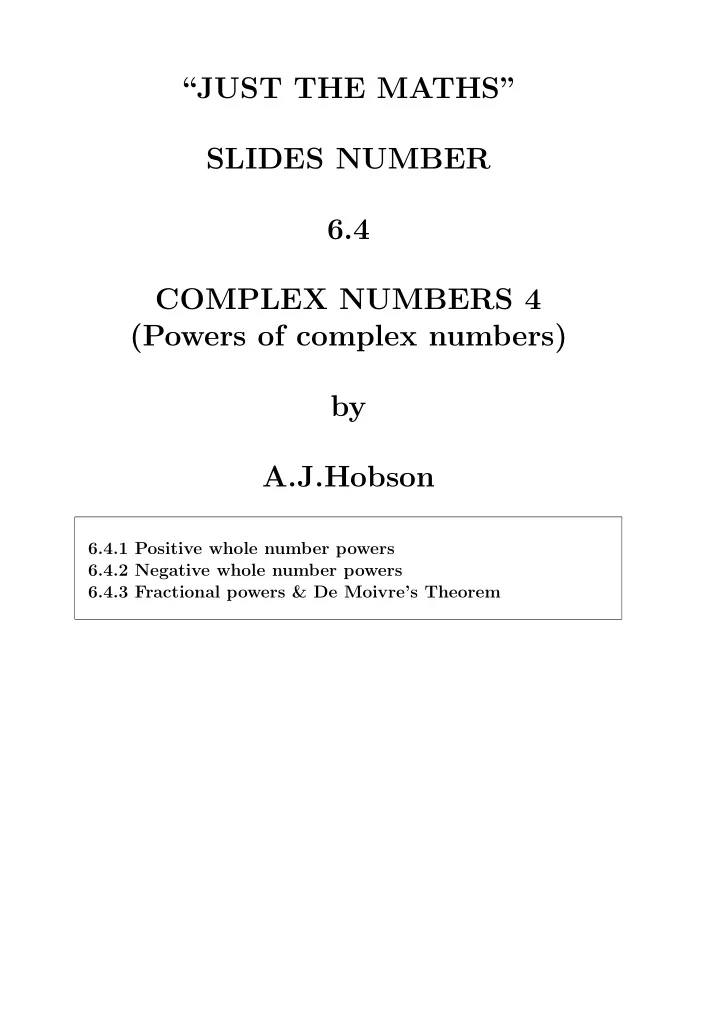

“JUST THE MATHS” SLIDES NUMBER 6.4 COMPLEX NUMBERS 4 (Powers of complex numbers) by A.J.Hobson 6.4.1 Positive whole number powers 6.4.2 Negative whole number powers 6.4.3 Fractional powers & De Moivre’s Theorem
UNIT 6.4 - COMPLEX NUMBERS 4 POWERS OF COMPLEX NUMBERS 6.4.1 POSITIVE WHOLE NUMBER POWERS Let z = r � θ. Then, z 2 = r.r � ( θ + θ ) = r 2 � 2 θ ; z 3 = z.z 2 = r.r 2 � ( θ + 2 θ ) = r 3 � 3 θ ; z n = r n � nθ. This result is due to De Moivre. EXAMPLE 19 1 2 + j 1 19 π π ) 19 = 1 � √ √ = (1 � 2 4 4 3 π = − 1 2 + j 1 √ √ = 1 � 2 . 4 1
6.4.2 NEGATIVE WHOLE NUMBER POWERS If n is a negative whole number, let n = − m, where m is a positive whole number. z n = z − m = 1 1 z m = r m � mθ ; 1 z n = r m (cos mθ + j sin mθ ) = 1 r m . (cos mθ − j sin mθ ) = r − m (cos[ − mθ ]+ j sin[ − mθ ]) cos 2 mθ + sin 2 mθ But − m = n , and so z n = r n (cos nθ + j sin nθ ) = r n � nθ. The result of the previous section remains true for nega- tive whole number powers. EXAMPLE √ 3 + j ) − 3 = (2 � 30 ◦ ) − 3 = 1 � ( − 90 ◦ ) = − j ( 8 . 8 2
6.4.3 FRACTIONAL POWERS AND DE MOIVRE’S THEOREM Consider the complex number 1 z n , where n is a positive whole number and z = r � θ . 1 n means any complex number which gives z itself when z raised to the power n . Such a complex number is called “an n -th root of z ” . One such possibility is n � θ 1 r n. But, in general, z = r � ( θ + k 360 ◦ ) , where k may be any integer; Hence, n � θ + k 360 ◦ 1 1 n = r z . n 3
The roots given by k = 0 , 1 , 2 , 3 ............n − 1 are also given by k = n, n + 1 , n + 2 , n + 3 , ......., 2 n − 1 , 2 n, 2 n + 1 , 2 n + 2 , 2 n + 3 , ..... There are precisely n n -th roots given by k = 0 , 1 , 2 , 3 ........., n − 1. EXAMPLE Determine the cube roots (i.e. 3rd roots) of the complex number j 8. Solution We first write j 8 = 8 � (90 ◦ + k 360 ◦ ). Hence, 3 � (90 ◦ + k 360 ◦ ) 1 1 3 = 8 ( j 8) , where k = 0 , 1 , 2 . 3 The three distinct cube roots are 2 � 30 ◦ , 2 � 150 ◦ and 2 � 270 ◦ = 2 � ( − 90 ◦ ) . They all have the same modulus of 2 but their arguments are spaced around the Argand Diagram at reg- ular intervals of 360 ◦ = 120 ◦ . 3 4
Notes: (i) The n -th roots of a complex number will all have the same modulus, but their arguments will be spaced at reg- ular intervals of 360 ◦ n . (ii) If − 180 ◦ < θ ≤ 180 ◦ , k = 0 gives the “principal n -th root” . (ii) If m n is a fraction in its lowest terms, m 1 m 1 n = or ( z m ) z z n . n DE MOIVRE’S THEOREM If z = r � θ , then, for any rational number n , one value of z n is r n � nθ . 5
Recommend
More recommend